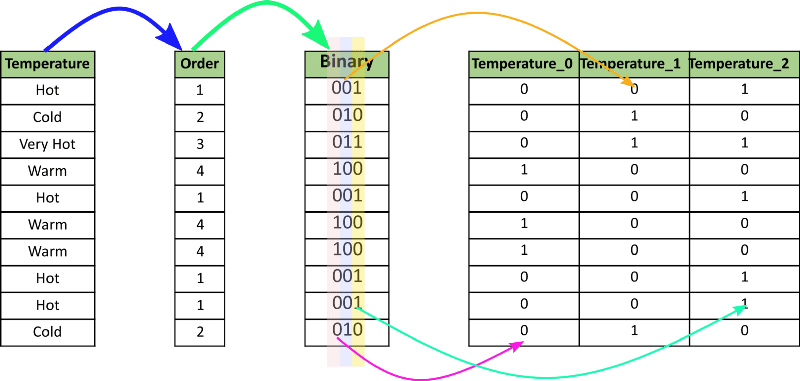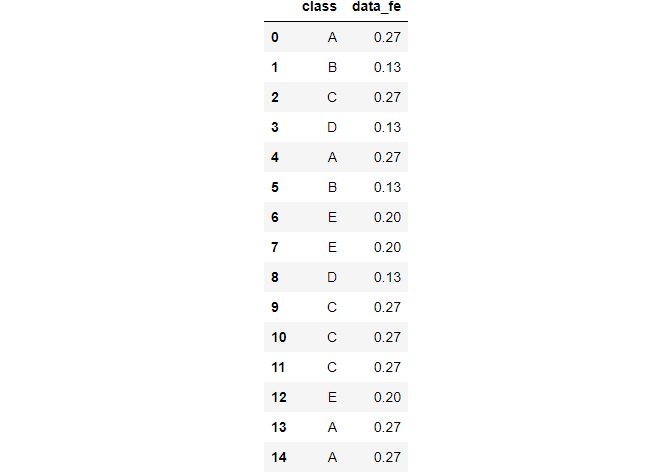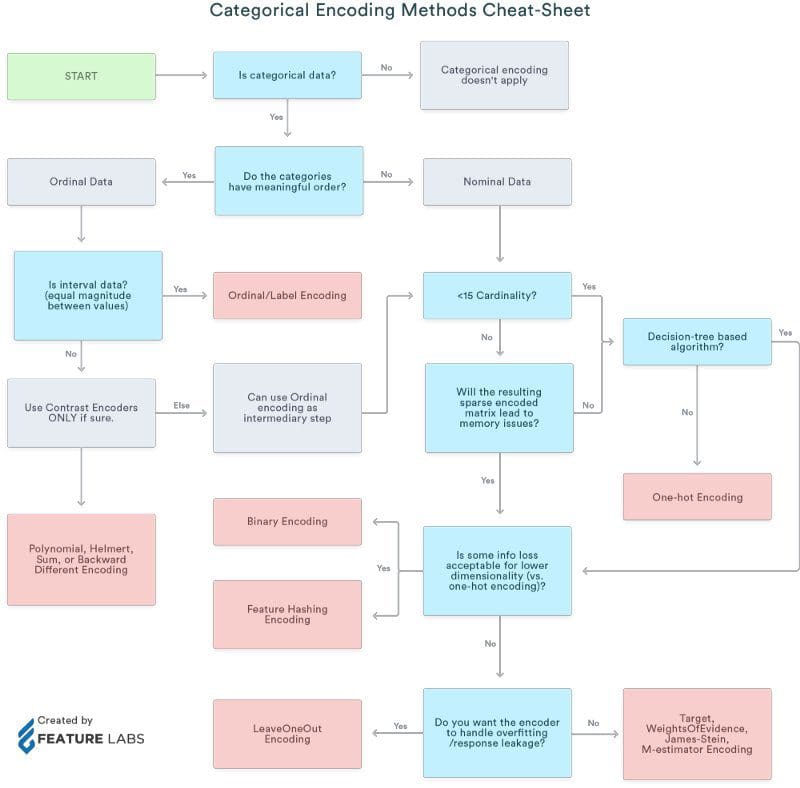How to Deal with Categorical Data for Machine Learning
(This article originally appeared on KDNuggets.com here. For more, visit https://www.kdnuggets.com/)
Check out this guide to implementing different types of encoding for categorical data, including a cheat sheet on when to use what type.
In this blog we will explore and implement:
- One-hot Encoding using:
- Python’s category_encoding library
- Scikit-learn preprocessing
- Pandas' get_dummies
- Binary Encoding
- Frequency Encoding
- Label Encoding
- Ordinal Encoding
What is Categorical Data?
Categorical data is a type of data that is used to group information with similar characteristics, while numerical data is a type of data that expresses information in the form of numbers.
Example of categorical data: gender
Why do we need encoding?
- Most machine learning algorithms cannot handle categorical variables unless we convert them to numerical values
- Many algorithm’s performances even vary based upon how the categorical variables are encoded
Categorical variables can be divided into two categories:
- Nominal: no particular order
- Ordinal: there is some order between values
We will also refer to a cheat sheet that shows when to use which type of encoding.
Method 1: Using Python’s Category Encoder Library
category_encoders is an amazing Python library that provides 15 different encoding schemes.
Here is the list of the 15 types of encoding the library supports:
- One-hot Encoding
- Label Encoding
- Ordinal Encoding
- Helmert Encoding
- Binary Encoding
- Frequency Encoding
- Mean Encoding
- Weight of Evidence Encoding
- Probability Ratio Encoding
- Hashing Encoding
- Backward Difference Encoding
- Leave One Out Encoding
- James-Stein Encoding
- M-estimator Encoding
- Thermometer Encoder
Importing libraries:
import pandas as pd
import sklearn
pip install category_encoders
import category_encoders as ceCreating a dataframe:
data = pd.DataFrame({ 'gender' : ['Male', 'Female', 'Male', 'Female', 'Female'],
'class' : ['A','B','C','D','A'],
'city' : ['Delhi','Gurugram','Delhi','Delhi','Gurugram'] })
data.head()
Image By Author
Implementing one-hot encoding through category_encoder
In this method, each category is mapped to a vector that contains 1 and 0 denoting the presence or absence of the feature. The number of vectors depends on the number of categories for features.
Create an object of the one-hot encoder:
ce_OHE = ce.OneHotEncoder(cols=['gender','city'])
data1 = ce_OHE.fit_transform(data)
data1.head()
Image By Author
Binary Encoding
Binary encoding converts a category into binary digits. Each binary digit creates one feature column.

Image Ref
ce_be = ce.BinaryEncoder(cols=['class']);
# transform the data
data_binary = ce_be.fit_transform(data["class"]);
data_binary
Image By Author
Similarly, there are another 14 types of encoding provided by this library.
Method 2: Using Pandas' get dummies
pd.get_dummies(data,columns=["gender","city"])
Image By Author
We can assign a prefix if we want to, if we do not want the encoding to use the default.
pd.get_dummies(data,prefix=["gen","city"],columns=["gender","city"])
Image By Author
Method 3: Using Scikit-learn
Scikit-learn also has 15 different types of built-in encoders, which can be accessed from sklearn.preprocessing.
Scikit-learn One-hot Encoding
Let's first get the list of categorical variables from our data:
s = (data.dtypes == 'object')
cols = list(s[s].index)
from sklearn.preprocessing import OneHotEncoder
ohe = OneHotEncoder(handle_unknown='ignore',sparse=False)Applying on the gender column:
data_gender = pd.DataFrame(ohe.fit_transform(data[["gender"]]))
data_gender
Image By Author
Applying on the city column:
data_city = pd.DataFrame(ohe.fit_transform(data[["city"]]))
data_city
Image By Author
Applying on the class column:
data_class = pd.DataFrame(ohe.fit_transform(data[["class"]]))
data_class
Image By Author
This is because the class column has 4 unique values.
Applying to the list of categorical variables:
data_cols = pd.DataFrame(ohe.fit_transform(data[cols]))
data_cols
Image By Author
Here the first 2 columns represent gender, the next 4 columns represent class, and the remaining 2 represent city.
Scikit-learn Label Encoding
In label encoding, each category is assigned a value from 1 through N where N is the number of categories for the feature. There is no relation or order between these assignments.
from sklearn.preprocessing import LabelEncoder
le = LabelEncoder()
Label encoder takes no arguments
le_class = le.fit_transform(data[["class"]])Comparing with one-hot encoding
data_class
Image By Author
Ordinal Encoding
Ordinal encoding’s encoded variables retain the ordinal (ordered) nature of the variable. It looks similar to label encoding, the only difference being that label coding doesn't consider whether a variable is ordinal or not; it will then assign a sequence of integers.
Example: Ordinal encoding will assign values as Very Good(1) < Good(2) < Bad(3) < Worse(4)
First, we need to assign the original order of the variable through a dictionary.
temp = {'temperature' :['very cold', 'cold', 'warm', 'hot', 'very hot']}
df=pd.DataFrame(temp,columns=["temperature"])
temp_dict = {'very cold': 1,'cold': 2,'warm': 3,'hot': 4,"very hot":5}
df
Image By Author
Then we can map each row for the variable as per the dictionary.
df["temp_ordinal"] = df.temperature.map(temp_dict)
df
Image By Author
Frequency Encoding
The category is assigned as per the frequency of values in its total lot.
data_freq = pd.DataFrame({'class' : ['A','B','C','D','A',"B","E","E","D","C","C","C","E","A","A"]})Grouping by class column:
fe = data_freq.groupby("class").size()Dividing by length:
fe_ = fe/len(data_freq)Mapping and rounding off:
data_freq["data_fe"] = data_freq["class"].map(fe_).round(2)
data_freq
Image By Author
In this article, we saw 5 types of encoding schemes. Similarly, there are 10 other types of encoding which we have not looked at:
- Helmert Encoding
- Mean Encoding
- Weight of Evidence Encoding
- Probability Ratio Encoding
- Hashing Encoding
- Backward Difference Encoding
- Leave One Out Encoding
- James-Stein Encoding
- M-estimator Encoding
- Thermometer Encoder
Which Encoding Method is Best?
There is no single method that works best for every problem or dataset. I personally think that the get_dummies method has an advantage in its ability to be implemented very easily.
If you want to read about all 15 types of encoding, here is a very good article to refer to.
Here is a cheat sheet on when to use what type of encoding:

Image Ref
References:
Stay in the loop.
Subscribe to our newsletter for a weekly update on the latest podcast, news, events, and jobs postings.




